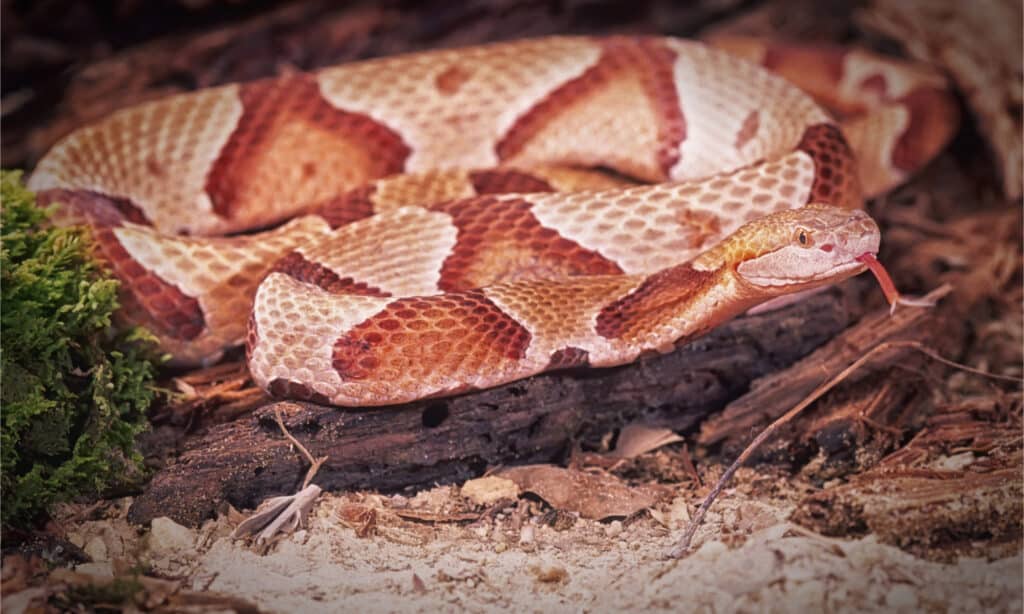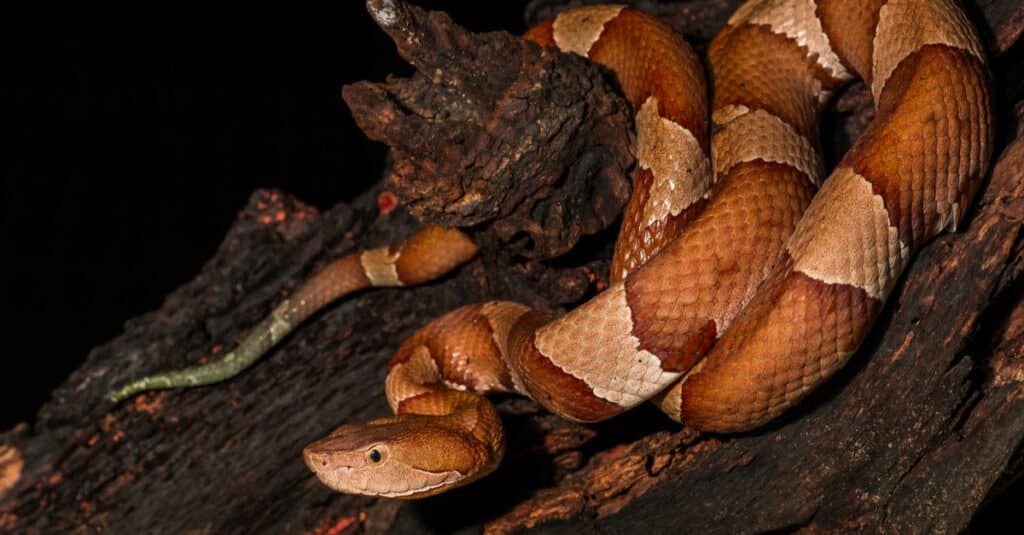It is common for copperheads to be found throughout North America, and this includes New Jersey. Copperheads get their name from their copper-red heads. Cottonmouths, rat snakes, Australian copperheads, and sharp-nosed pit vipers are all examples of snakes referred to as “copperheads,” but they are different from the venomous North American copperhead, which is found solely in the Americas.
The Midwest and the South are the most common locations for North American copperheads, but they can even be found in more crowded urbanized areas like New Jersey. Although they carry venom, the bites of these creatures are rarely lethal. However, it’s still a good idea to know where they are and how often they bite so that you can keep yourself as secure as possible while outdoors.
What Do Copperheads in New Jersey Look Like?

The body of the copperhead ranges from 2 to usually less than 4 feet.
©outdoorsman/Shutterstock.com
The reddish-brown, coppery body of the northern copperhead bears chestnut brown crossbands and an unmarked, copper-colored head. Both the wide and narrow portions of the hourglass-shaped bands cross the snake’s back at its tailbone, forming a protective barrier around its body. A mature copperhead can reach a length of 24 to 36 inches when completely grown. When they are young, copperheads measure between 7 and 10 inches in length.
Most Active Periods for Copperheads in New Jersey

Copperheads are usually encountered in New Jersey from May to October,
©iStock.com/David Kenny
Every year in the winter, copperhead and other snakes go into brumation. Winter hibernation for warm-blooded mammals is analogous to this. During this time, they tend to stay hidden and move very little, if at all. Snake brumation can begin between September and December and last until March or April, depending on the temperature. Snakes emerge from brumation when the weather warms their blood, resulting in them becoming more active.
In New Jersey, the months of May through October are common periods for encountering copperheads. They will burrow or den underground, in rocky places, animal burrows, or hollow logs during the winter. Copperheads, like many other snakes, are active during the day in the spring and fall before becoming nocturnal in summer.
Most Active Areas for Copperheads in New Jersey
The Northern copperhead is one of the most well-known venomous snakes in the state of New Jersey. Copperheads are found in the northern part of the state of New Jersey, which spans from the Sourlands of Hunterdon, Mercer, and Somerset counties to the New Jersey–New York state line in the north. In addition, they can be seen within the Palisades in Bergen County.
Copperheads are most common in rural areas of New Jersey, but they have also been spotted in suburban and even some metropolitan areas. They are usually unearthed beneath leaf piles or in potted plants. In addition, they frequently establish their homes within holes that have been carved out of wood by other animals. Dens frequently found by these snakes include stones, stumps, and caves.
Are Copperheads In New Jersey Venomous?

Copperheads are venomous!
©Wildvet/Shutterstock.com
Copperheads are known to be dangerous, and there is no exception when it comes to the ones found in New Jersey. They have hemotoxic venom, which can cause temporary tissue damage in the biting location. The United States sees several thousand cases of people being bitten by poisonous snakes on an annual basis. Children and those whose immune systems are already compromised are at a greater risk of adverse effects from the venom and the therapy. If a poisonous snake has bitten you, dial 911 immediately. It is critical that anti-venom be administered into your system as quickly as possible.
How Often Do Copperheads Bite?
According to the American Copperhead Association, copperheads bite almost 3,000 people in the United States each year. According to the numbers, which equates to 16.4 bites per million individuals. These snakes have a wide range of temperaments. When it comes to biting, some are apprehensive, while others are fearless. It is common for them to become more aggressive if stumbled upon at night than when disturbed during the day.
In Conclusion

Copperheads in New Jersey are designated as species of Special Concern.
©Creeping Things/Shutterstock.com
Copperhead numbers in the state of New Jersey are dwindling, mostly because of the harassment they receive from humans. Because they hunt other creatures and are also prey for other animals, snakes play an extremely vital role in maintaining the health of the environment. Keep in mind, if snakes aren’t your thing, that most snakes aren’t aggressive unless they’re protecting themselves from something.
The main thing to do is to leave these snakes alone and back away calmy if you happen to approach one. Antagonizing it will surely lead to a bite with potentially deadly consequences. Copperheads are protected by law and are designated as a Species of Special Concern under New Jersey’s statute. As a direct result of this, it is against the law to bother, harass, or otherwise cause harm to copperheads or any other species of snake.
The photo featured at the top of this post is © Creeping Things/Shutterstock.com
Discover the "Monster" Snake 5X Bigger than an Anaconda
Every day A-Z Animals sends out some of the most incredible facts in the world from our free newsletter. Want to discover the 10 most beautiful snakes in the world, a "snake island" where you're never more than 3 feet from danger, or a "monster" snake 5X larger than an anaconda? Then sign up right now and you'll start receiving our daily newsletter absolutely free.
Thank you for reading! Have some feedback for us? Contact the AZ Animals editorial team.






